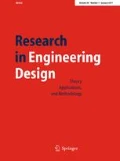Abstract
Over the last 12 years, the design research group at the Key Centre for Computing at the University of Sydney has been developing an extensive model of designing, looking at designing as a process in which the concepts of function, behaviour and structure of artefacts play a central role. In this paper, we critically analyse this model of designing, focussing on its internal clarity and external empirical validation. We review the model and present the definitions of the key concepts function, behaviour and structure. In doing so we show that one can distinguish at least two different versions of the model. Finally, we raise fundamental questions about the precise location of the transition between structural and intentional descriptions of artefacts in these versions, and about the empirical status of the model as a whole.


Similar content being viewed by others
Notes
The described characterisation of intentionality as the capacity of organisms to be directed at objects and state of affairs in the world has as a consequence that the intentional description does not cover all mental states: ‘pain’ is the standard example of a mental state that need not be directed at something in the world.
E.g., Gero (1990, p. 31).
E.g., Tham, et al. (1990, p. 513).
E.g., Gero, et al. (1992, p. 198).
Gero (1990, pp. 30–32), Tham, et al. (1990, p. 512), and Gero, et al . (1992, pp. 213–215) all give the prototype for window design that describes this structure.
See, for instance, Gero (1990, figure 4c)
We take the documentation step as a step in which some of the properties of the structure S of the artefact relevant to its manufacturing are recorded.
Searle (1995).
The fact that construction costs of an artefact may be objective determined given certain prices of materials (and labour) is not turning this concept into a structural one. Intentional descriptions may be to a large extent objective as is exemplified by, for instance, the intentional description that John desired an electrical train.
The terminology used in Rosenman and Gero (1998) differs slightly from Gero’s earlier and later terminology. Rosenman and Gero (1998) speak about required instead of expected purposes, functions and behaviours. And their term for actual purpose is ‘utility’. We have changed this terminology in order to stress the continuity in (the development in) the work of Gero and his collaborators.
Rosenman and Gero (1998, p. 168).
Rosenman and Gero (1998, p. 170).
Rosenman and Gero (1998, figure 3).
Rosenman and Gero (1998,§ 3.1).
Kannengiesser (private communication, 2002).
Gero and Rosenman (1990, p. 68).
Cross, Christiaans and Dorst (1996).
Gero (1990, p. 27).
References
Bobrow DG (1984) (ed) Qualitative Reasoning about Physical Systems. Elsevier: Amsterdam. Reprinted from (1984) Artificial Intelligence 24
Crane T (1998) Intentionality. In: Craig, E. (Ed.) Routledge Encyclopedia of Philosophy, Volume 4. Routledge: London, pp 816–821
Cross NG, Christiaans HHCM, Dorst K (eds) (1996) Analysing Design Activity. John Wiley, Chichester
Dorst CH (1997) Describing Design - A Comparison of Paradigms. PhD. thesis, Delft University of Technology
Gero JS (1990) Design Prototypes: A Knowledge Representation Schema for Design. AI Magazine 11(4): 26–36
Gero JS (2002) Categorising Technological Knowledge From a Design Methodological Perspective. Paper presented at the conference ‘Technological Knowledge: Philosophical Reflections’, Boxmeer, The Netherlands, June 13–15
Gero JS, Kannengiesser U (2002) The Situated Function-Behaviour-Structure Framework. In: Gero JS (ed) Artificial Intelligence in Design ‘02. Kluwer, Dordrecht, pp 89–104
Gero JS, McNeill T (1998) An Approach to the Analysis of Design Protocols. Design Studies 19:21–61
Gero JS, Rosenman MA (1990) A Conceptual Framework for Knowledge-Based Design Research at Sydney University’s Design Computing Unit. Artificial Intelligence in Engineering 5(2):65–77
Gero JS, Tham KW, Lee HS (1992) Behaviour: A Link Between Function and Structure in Design. In: Brown DC, Waldron MB, Yoshikawa H (eds) Intelligent Computer Aided Design. Elsevier, Amsterdam, pp 193–225
Kroes PA, Meijers AWM (2002) The Dual Nature of Technical Artifacts: Presentation of a New Research Program. Techne 6(2), http://scholar.lib.vt.edu/ejournals/SPT/v6n2/kroes.html
Purcell AT, Gero JS, Edwards H, McNeill T (1996) The Data in Design Protocols: The Issue of Data Coding, Data Analysis in the Development of Models of the Design Process. In: Cross NG, Christiaans HHCM, Dorst K (eds) Analysing Design Activity, Wiley, Chichester, pp 225–252
Roozenburg NFM, Eekels J (1995) Product Design: Fundamentals and Methods. Wiley, Chichester
Rosenman MA, Gero JS (1998) Purpose and Function in Design: From the Socio-Cultural to the Techno-Physical. Design Studies 19:161–186
Searle JR (1995) The Construction of Social Reality. Free Press, New York
Tham KW, Lee HS, Gero JS (1990) Building Envelope Design Using Design Prototypes. ASHRAE Transactions 96:508–520
Acknowledgements
The authors wish to thank Larry Bucciarelli and Jeroen de Ridder for their participation in the discussions that led to this paper. Research by Pieter Vermaas was part of the program ‘The Dual Nature of Technical Artefacts’, which is supported by the Netherlands Organisation of Scientific Research (NWO) and research efforts by the Technè group.
Author information
Authors and Affiliations
Corresponding author
Rights and permissions
About this article
Cite this article
Dorst, K., Vermaas, P.E. John Gero’s Function-Behaviour-Structure model of designing: a critical analysis. Res Eng Design 16, 17–26 (2005). https://doi.org/10.1007/s00163-005-0058-z
Received:
Revised:
Accepted:
Published:
Issue Date:
DOI: https://doi.org/10.1007/s00163-005-0058-z



